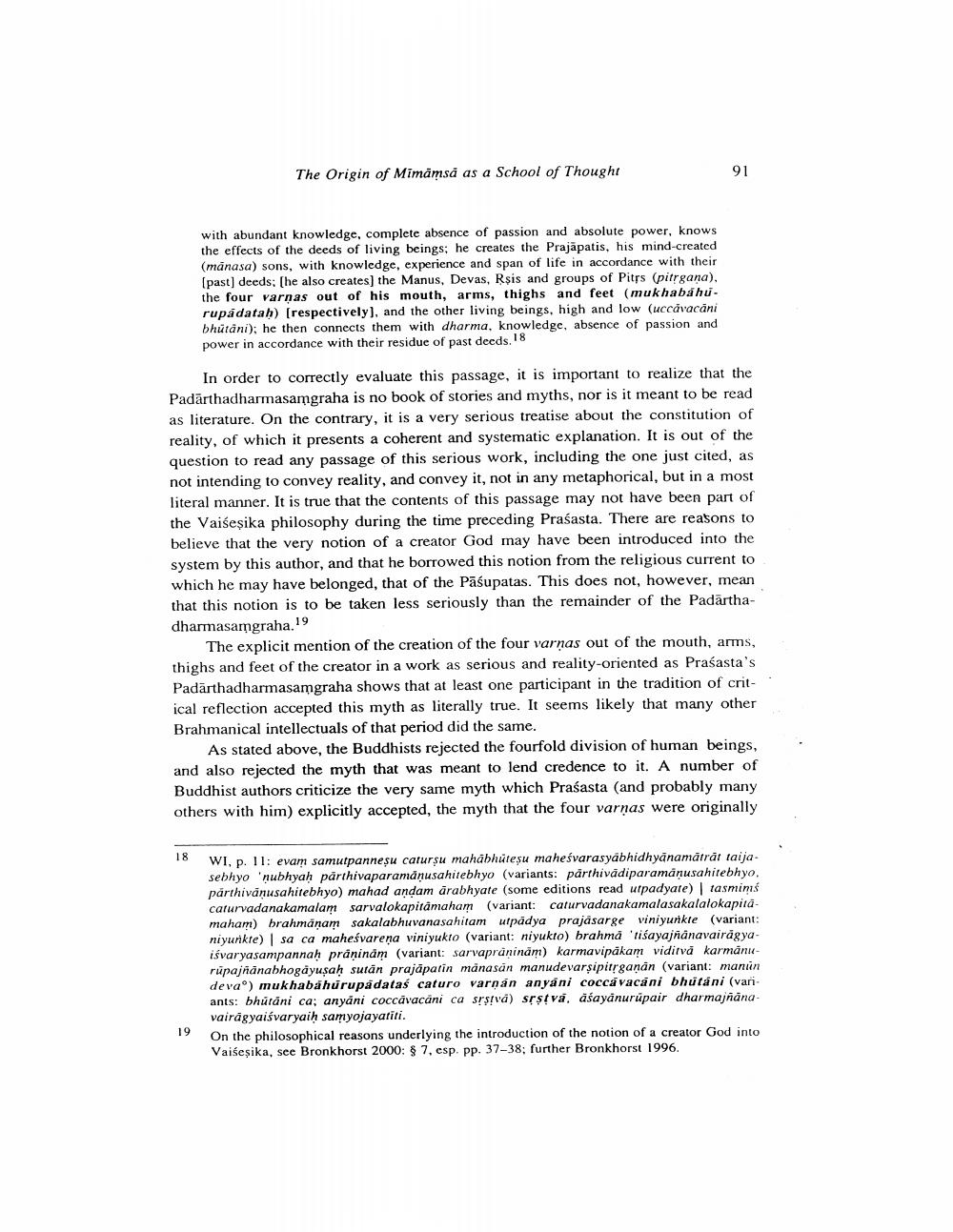Book Title: Origin Of Mimamsa As A School Of Thought A Hypothesis Author(s): Johannes Bronkhorst Publisher: Johannes Bronkhorst View full book textPage 9
________________ The Origin of Mimämsä as a School of Thought 18 with abundant knowledge, complete absence of passion and absolute power, knows the effects of the deeds of living beings; he creates the Prajapatis, his mind-created (mānasa) sons, with knowledge, experience and span of life in accordance with their [past] deeds; [he also creates] the Manus, Devas, Rsis and groups of Pitrs (pitrgana), the four varnas out of his mouth, arms, thighs and feet (mukhabahurupadataḥ) [respectively], and the other living beings, high and low (uccavacāni bhütäni); he then connects them with dharma, knowledge, absence of passion and power in accordance with their residue of past deeds. 18 In order to correctly evaluate this passage, it is important to realize that the Padarthadharmasamgraha is no book of stories and myths, nor is it meant to be read as literature. On the contrary, it is a very serious treatise about the constitution of reality, of which it presents a coherent and systematic explanation. It is out of the question to read any passage of this serious work, including the one just cited, as not intending to convey reality, and convey it, not in any metaphorical, but in a most literal manner. It is true that the contents of this passage may not have been part of the Vaiseṣika philosophy during the time preceding Prasasta. There are reasons to believe that the very notion of a creator God may have been introduced into the system by this author, and that he borrowed this notion from the religious current to which he may have belonged, that of the Pasupatas. This does not, however, mean that this notion is to be taken less seriously than the remainder of the Padarthadharmasamgraha.19 19 91 The explicit mention of the creation of the four varņas out of the mouth, arms, thighs and feet of the creator in a work as serious and reality-oriented as Prasasta's Padarthadharmasamgraha shows that at least one participant in the tradition of critical reflection accepted this myth as literally true. It seems likely that many other Brahmanical intellectuals of that period did the same. As stated above, the Buddhists rejected the fourfold division of human beings, and also rejected the myth that was meant to lend credence to it. A number of Buddhist authors criticize the very same myth which Prasasta (and probably many others with him) explicitly accepted, the myth that the four varṇas were originally WI, p. 11: evam samutpanneşu caturşu mahabhüteşu maheśvarasyabhidhyānamātrāt taijasebhyo 'nubhyaḥ parthivaparamāņusahitebhyo (variants: parthivadiparamāṇusahitebhyo. parthiväṇusahitebhyo) mahad anḍam arabhyate (some editions read utpadyate) | tasmims caturvadanakamalam sarvalokapitämaham (variant: caturvadanakamalasakalalokapitā maham) brahmanam sakalabhuvanasahitam utpädya prajäsarge viniyunkte (variant: niyunkte) | sa ca maheśvarena viniyukto (variant: niyukto) brahma 'tiśayajñānavairagyaiśvaryasampannaḥ präninām (variant: sarvapraninām) karmavipäkam viditva karmānurupajñānabhogayuṣaḥ sutan prajapatin mänasan manudevarṣipitṛganan (variant: manun deva°) mukhabähürupadataś caturo varṇan anyani cocca vacani bhütäni (variants: bhutani ca; anyani coccävacani ca sṛṣṭvā) sṛṣṭvā, āśayanurüpair dharmajñānavairágyaiśvaryaiḥ samyojayatiti. On the philosophical reasons underlying the introduction of the notion of a creator God into Vaiseşika, see Bronkhorst 2000: § 7, esp. pp. 37-38; further Bronkhorst 1996.Page Navigation
1 ... 7 8 9 10 11 12 13 14 15 16 17 18 19 20 21
